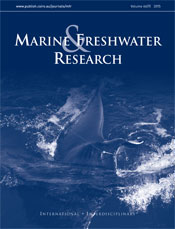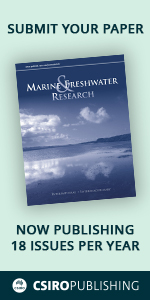Marine and Freshwater Research
Volume 66
Number 9 2015
Does global warming of the sea surface decrease or increase phytoplankton abundance? This paper shows that, although within-season phytoplankton abundance decreases with increasing water temperature, annual average phytoplankton abundance increases with average water temperature, likely because an increase of 1°C lengthens the growth season by ~20 days. However, it is not known if higher annual average phytoplankton abundance translates into larger stocks of zooplankton and fish.
This paper presents the first by-catch assessment of mobulid rays in pelagic longline fisheries over the south-western Atlantic. At least two species were indentified and, although by-catch frequency was low, some uncertainties remained regarding their post-capture mortality. This work sheds light on mobulids’ interaction with longline fisheries, expands known distribution ranges, and raises concern about the potential effect of these fisheries on mobulid populations.
Imposex is mainly caused by organotins’ accumulation in gastropods tissues. This research aimed to study the imposex in of Stramonita haemastoma individuals collected along the rocky coastline of the Gulf of Tunis. Sexual modifications occurred to different degrees in all stations essentially close to harbours. An inverse relationship between the distances from harbours and the occurrence of imposex was observed.
The effect of boat anchoring on the Mediterranean endemic bivalve Pinna nobilis was assessed experimentally in the field by deploying non-biological mimic units. Boat anchoring influence was three times higher in affected than in control areas, having also an adverse effect on Posidonia oceanica meadows. Moreover, lower values of natural P. nobilis density and size classes were recorded from the affected areas.
Oithona nana and O. helgolandica population dynamics and the influence of physical and trophic factors were studied at an estuarine system. O. nana proliferates near river runoff, mainly because a retention mechanism and a potential ecological advantage of this species denoted in body size and egg number and size. O. helgolandica populations did not increase in this system.
Understanding the role of agriculture in water quality and river health is vital. This study investigated the effect of agricultural run-off on the chemical and biological status of the hyporheic zone, and indicates that hyporheic zones are degraded in intensely farmed catchments. These findings emphasise the importance of holistic catchment management in the protection and sustainability of freshwater systems.
The present study investigated the behaviour of the apple snail Pomacea bridgesii on a simulated flood-pulse water regime. The results show that there are differences between day and night behaviours (activity and substrate selection). There were also differences between behaviours in dry and maximum water-level periods. Therefore, the floodplain regime influences the activity of P. brigesii displaying adaptations to minimise water loss.
Understanding the links between fish recruitment and riverine flows is integral for setting priorities for river-management strategies. We found that within-channel flow events soon after months of no-flow were important spawning triggers for the endemic Lake Eyre golden perch (Macquaria sp.). Subsequent fish recruitment was also strongly associated with the number of flow-events per year. These results highlight the importance of maintaining the naturally variable flow regime of Australia’s arid- and semi-arid zone rivers.
Questions related to the preservation of foraging sites of breeding birds have received little attention, although they can be of major importance for population persistence. Here, we used stable isotopes and field observations to evaluate the relative importance of man-made irrigation ponds as foraging areas for a larid community of conservation concern. Our study showed that larids breeding in mixed colonies segregate spatially in their foraging niche between marine and freshwater environments. Both breeding and foraging habitats need to be addressed when analysing larid population dynamics and conservation strategies.
One beach is not the same as another as far as a beach nesting-bird, the Hooded Plover, is concerned. They breed in sites with more invertebrate prey, and which have different assemblages of prey species, compared with sites where they do not breed. Thus, beaches apparently vary in terms of their ability to support this threatened bird species.
In Guadeloupe, the two endangered Acropora species are critically declining, like in the rest of Caribbean reefs. While examining the genetic status of two main remnant populations, we found an extremely high clonality in both species. This is alarming in the context of ongoing global warming as long periods of clonal growth without sexual recruitment may lead to the extinction of these populations.
The reproductive biology of planktonic chaetognaths is poorly known, particularly with regard to the importance of seasonal factors. We undertook a year of semilunar plankton sampling in the Hauraki Gulf, New Zealand, to survey sexual maturity of Aidanosagitta regularis; surprisingly, breeding of A. regularis appeared unconstrained by seasonal factors, as reproductively mature individuals were available year-round. This has implications for embryological study of the chaetognaths.




